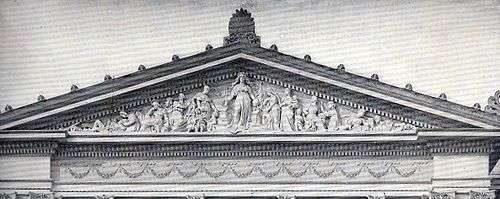Alice Rideout
Alice Rideout (born 1874) was an American sculptor born in Marysville, California who is primarily known for her work on the Women's Building at the 1893 World's Columbian Exposition in Chicago.
Biography
Alice Rideout was born in Marysville, CA in 1874. Her father was Captain J. Ransom Rideout. He had a fleet of steamers on San Francisco Bay.[1]
As a girl Rideout moved to San Francisco, where she attended high school. She went on to attend the San Francisco School of Design, where she studied with Rupert Schmid.
At the age of 19 Rideout won a competition to produce the architectural sculpture for the pediment of the Women's Building at the 1893 World Fair.[2]
After the Fair Rideout returned to San Francisco and married Fred Canady. She abandoned her art career, and moved to New York, where she remarried, and "disappeared from history."[1][3]
For the decorative, as for the structural scheme, designs were invited among women qualified for such work throughout the United States, and after eager and close competition the prize was awarded to Alice Rideout, of San Francisco. The pediment and symbolic groups of the roof-garden were her work. On the roof were winged groups typical of feminine characteristics and virtues, in choicest symbolism. One of the central figures represented the spirituality of woman, and at her feet a pelican, emblem of love and sacrifice. In the same group charity was side by side with virtue, and sacrifice was further symbolized by a nun, placing her jewels on the altar. Another group represented the genius of civilization, a student at her right and a woman at her left struggling through darkness for the light. All these and other groups represent the genius and labor of Miss Alice Rideout. The center of the pediment was occupied by Minerva with Wisdom's owl at her feet, and on either side, women's work in the progress of civilization was typified by literature, art, and home life.[4]

References
- 1 2 "Alice Rideout". AskArt. Retrieved 2013-10-28.
- ↑ Petteys, Chris, ‘’Dictionary of Women Artists’’, G K Hill & Co. publishers, 1985
- ↑ Weinmann, Jeanne Madeline, ‘’The Fair Women’’’, Academy Chicago, Chicago, Illinois, 1981 p. 174
- ↑ Armstrong, Geneva (1900). Woman in art. Retrieved 2013-10-28.